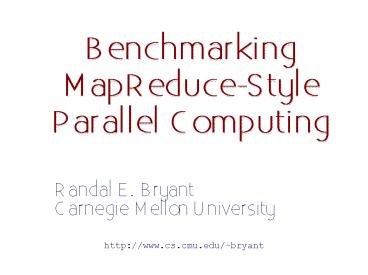Benchmarking MapReduceStyle Parallel Computing - PowerPoint PPT Presentation
1 / 14
Title:
Benchmarking MapReduceStyle Parallel Computing
Description:
Can apply MapReduce style computation to many other application domains. Give it a Try! ... High-speed, local network using commodity technology. E.g., gigabit ... – PowerPoint PPT presentation
Number of Views:70
Avg rating:3.0/5.0
Title: Benchmarking MapReduceStyle Parallel Computing
1
BenchmarkingMapReduce-StyleParallel Computing
Randal E. Bryant Carnegie Mellon University
http//www.cs.cmu.edu/bryant
2
Programming with MapReduce
- Background
- Developed at Google for aggregating web data
- Dean Ghemawat MapReduce Simplified Data
Processing on Large Clusters, OSDI 2004 - Strengths
- Easy way to write scalable parallel programs
- Powerful programming model
- Beyond web search applications
- Runtime system automatically handles many of the
challenges of parallel programming - Scheduling, load balancing, fault tolerance
3
Overall Execution Model
- General Form
- Input
- Large set of files
- Compute
- Aggregate information
- Output
- Files containing aggregations
- Example Word Count Index
- Input
- 1010 cached web pages
- Stored on cluster of 1000 machines, each with own
local disk - Compute
- Index of words with occurrence counts
- Output
- File containing count for each word
4
MapReduce Programming
- Map
- Function generating keyword/value pairs from
input file - E.g., word/count for each word in document
- Reduce
- Function aggregating values for single keyword
- E.g.,Sum word counts
5
MapReduce Implementation
- (Somewhat naïve implementation)
- Map
- Spawn mapping task for each input file
- Execute on processor local to file
- Generate file for each keyword/value
- Shuffle
- Redistribute files by hashing keywords K gt Ph(K)
- Reduce
- Spawn reduce task for each keyword
- On processor to which keyword hashes Ph(K)
6
Appealing Features
- Ease of Programming
- Programmer provides only two functions
- Express in terms of computation over data, not
detailed execution on system - Robustness
- Tolerant to failures of disks, processors,
network - Source files stored redundantly
- Runtime monitor detects and reexecutes failed
tasks - Dynamic scheduling automatically adapts to
resource limitations
7
Tolerating Failures
- Dean Ghemawat, OSDI 2004
- Sorting 10 million 100-byte records with 1800
processors - Proactively restart delayed computations to
achieve better performance and fault tolerance
8
Our Data-Driven World
- Science
- Data bases from astronomy, genomics, natural
languages, seismic modeling, - Humanities
- Scanned books, historic documents,
- Commerce
- Corporate sales, stock market transactions,
census, airline traffic, - Entertainment
- Internet images, Hollywood movies, MP3 files,
- Medicine
- MRI CT scans, patient records,
9
Big Data Computing Beyond Web Search
- Application Domains
- Rely on large, ever-changing data sets
- Collecting maintaining data is major effort
- Computational Requirements
- Extract information from large volumes of raw
data - Hypothesis
- Can apply MapReduce style computation to many
other application domains - Give it a Try!
- Hadoop Open source implementation of parallel
file system MapReduce
10
Q1 Workload Characteristics
- Hardware
- 1000s of nodes
- Each with processor(s), disk(s), network
interface - High-speed, local network using commodity
technology - E.g., gigabit ethernet with switches
- Data Organization
- Distributed file system providing uniform name
space and redundant storage - Computation
- Each task executed as separate process with file
I/O - Rely on file system for data transfer
11
Q2 Hardware/Software Challenges
- Performance Issues
- Disk bandwidth limitations
- ? 3.6 hours to read data from 1TB disk
- Data transfer across network
- Process file I/O overhead
- Runtime Issues
- Detecting and mitigating effects of failed
components
12
Q3 Benchmarking Challenges
- Generalizing Results
- Beyond specific data set cluster configuration
- Performance depends on many different factors
- Can we predict how program will scale?
- Identifying Bottlenecks
- Many interacting parts to system
- Evaluating Robustness
- Creating realistic failure modes
13
Q4 University Contributions
- Currently Industry ahead of universities
- Dealing with massive data sets
- Computing at very large scale
- Developing new programming/runtime approaches
- Google, Yahoo!, Microsoft
- University Role
- More open and systematic inquiry
- Apply to noncommercial problems
- Extend and improve programming model and
notations - Expose students to emerging styles of computing
14
Background Information
- Data-Intensive Supercomputing The case for
DISC - Tech Report CMU-CS-07-128
- Available from http//www.cs.cmu.edu/bryant































